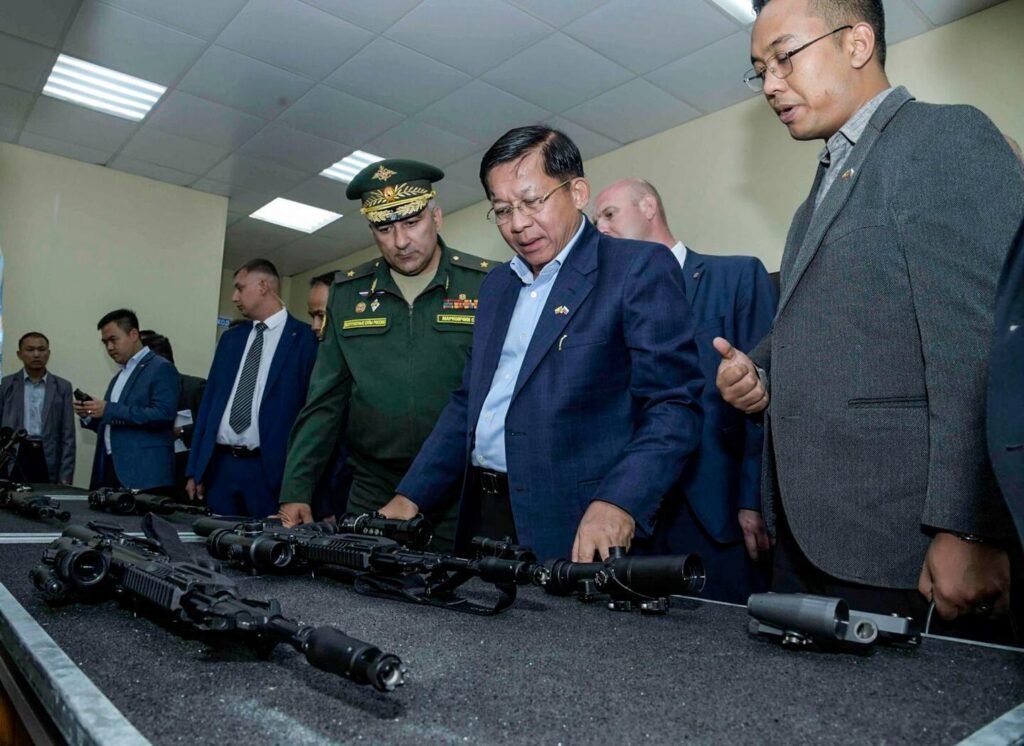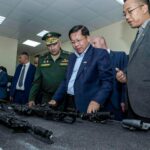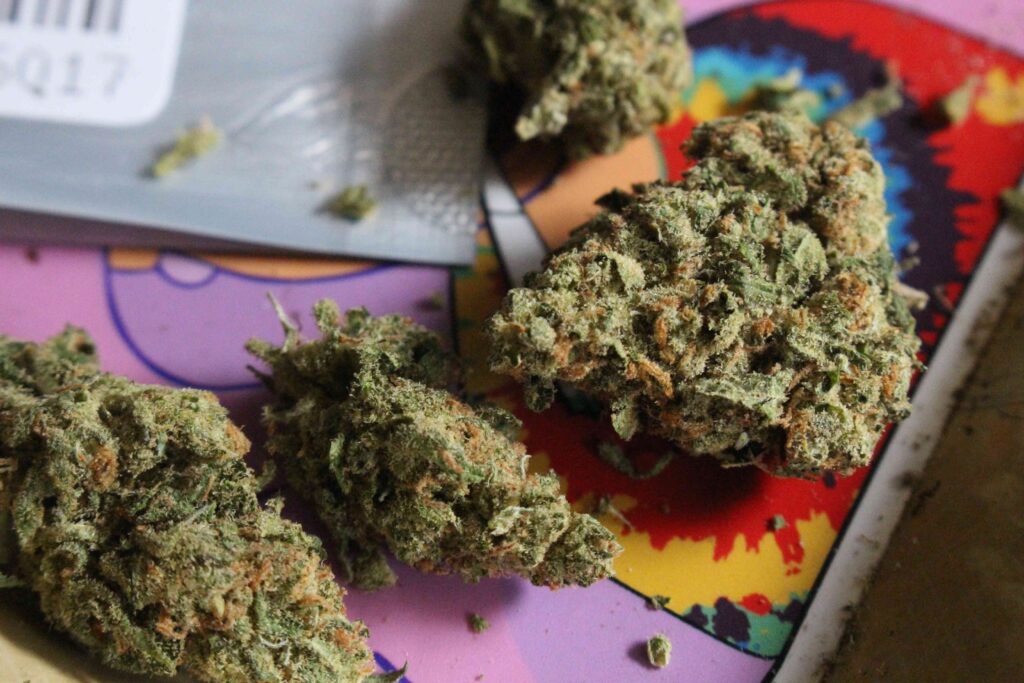MANTRAYA ANALYSIS #92: 09 OCTOBER 2025
BIBHU PRASAD ROUTRAY
Abstract
Since late 2023, predictions of an impending defeat for the Myanmar military junta have been prominent in scholarly analyses and media reports. However, despite suffering several losses and controlling less than a third of the country’s territory, the junta remains firmly in power. Furthermore, in recent months, it has managed to regain some lost territory. A steady flow of military hardware from external sources plays a crucial role in this. Recent trends suggest the possibility of further territorial gains for the junta as resistance movements face significant obstacles.

(Myanmar junta chief Senior Gen. Min Aung Hlaing and his team inspect weapons and equipment
at the Higher Military Command School in Novosibirsk, Russia, 16 July 2022. Photo Credit: Myanmar military)
Unsavoury Friends in a Time of Need
Since the military’s 2021 coup in Myanmar, military supplies from both China and Russia have played a critical role in the junta’s survival against the onslaught of the ethnic armed organisations (EAOs) and the People’s Defence Forces (PDFs). In May 2023, the UN Special Rapporteur published an evidence-based account concluding Myanmar, since the coup, had imported arms, ammunition, dual-use goods and manufacturing inputs worth $1 billion. The report named suppliers and routes traceable to China and Hong Kong among the largest contributors.[1]
The requirement of the junta reached critical levels after the launch of Operation 1027 in October 2023 by the Three Brotherhood Alliance, comprising three EAOs—TNLA, AA, and MNDFF. Relentless operations by the TBA posed a host of problems for the junta in terms of loss of territory, key military camps and bases falling into the hands of the EAOs, low morale, and a noticeable rise in desertions from the ranks. The Junta needed arms and needed them quickly. And both China and Russia stepped in.
The supply of kinetic weaponry increased. The second batch of FTC-2000G trainers, which had originally been purchased in 2020, was delivered in August 2024, and three more in December 2024. This brought the total number of FTC-2000Gs to 15.[2] Six more are due to be delivered in 2025. In the absence of an adequate number of fly-worthy planes, the FTC-2000Gs form a critical part of the junta’s aerial posture over EAO and PDF strongholds. Russia has delivered six SU-30s to the MAF between 2022 and 2024.
In 2024, a Special Advisory Council for Myanmar (SAC-M) report found that a state-owned Chinese company, China South Industries Corporation (CSIC), was assisting the junta in producing aerial bombs. By 2025, Chinese state-owned arms makers, such as NORINCO, were supplying the junta with weapons and military technology, including components that bolster domestic weapons production. China also remains the predominant supplier of drones to the junta, which has become the latter’s mainstay weapon against EAOs and PDF strongholds since late 2024.
Myanmar’s dealings with Russia have intensified since the coup. Junta chief Min Aung Hlaing has travelled to Russia seven times since 2021, including four visits in the first nine months of 2025. Some of these visits have included gratifying and yet uncommon gestures, such as Ming Hlaing cooking meals and preparing “milk tea” for Russian officials. In September 2025, Aung Hlaing travelled to Moscow to attend the World Atomic Week forum at the invitation of Russian President Vladimir Putin.[3]
Russia also remains key to the junta’s nuclear power dreams. In September 2022, the junta and Russia’s State Atomic Energy Corporation signed an agreement to jointly assess building a small reactor in Myanmar. Subsequently, a Nuclear Technology Information Centre was opened in Yangon in 2023.
A Helping Hand
The listing of weapons delivered by Russia and China cited above is by no means exhaustive. It merely indicates the extent to which both these countries have contributed to the military potency of an otherwise demoralised and depleted junta, and have served to keep it in power.
Since independence, Myanmar has engaged only in irregular conflicts with internal challengers, primarily so-called ethnic armed organisations (EAOs). After a pro-democracy uprising, most Western powers placed a de facto arms embargo on Myanmar. To re-equip its military, Myanmar turned to large-scale arms deals with China. In 1989, a high-level Myanmar military delegation visited China to negotiate arms purchases. The first major shipment of Chinese arms, including anti-aircraft guns and small arms, arrived in Yangon in August 1990. Since then, the Chinese arms and munitions have been the backbone of the junta’s capacity.
Beginning in the 2000s, though, Myanmar’s military diversified its arms imports, seeking Russian aircraft and other military equipment. By 2016, the two countries had signed a formal defence cooperation agreement. Nevertheless, Chinese arms sales, according to the Stockholm International Peace Research Institute (SIPRI), increased significantly during 2012-2022, especially after Xi Jinping took power in China.
In 2022, a year after the military orchestrated a coup to take over power in Myanmar, the Yangon-based Royal Shune Lei Corporation Ltd (also known as Progress Technology Support Company) brokered a deal between the Myanmar military junta and the Korea Mining Development Trading Corporation (KOMID). KOMID is a North Korean (DPRK) state-owned company that serves as Pyongyang’s primary arms dealer and exporter for ballistic missile and conventional weapons-related goods and equipment.
Since 2014, KOMID has been a UN-designated entity, identified as being “engaged in or providing support for, including through other illicit means, DPRK’s nuclear-related, other weapons of mass destruction-related and ballistic missile-related programmes.”[4] Despite sanctions, KOMID has proven resilient, adapting its methods to continue its operations. After being placed under UN sanctions, it reportedly transferred some activities to other North Korean entities, a network of subsidiaries, and front companies.
In 2018, Myanmar’s civilian government under Aung San Suu Kyi had severed ties with North Korea, in line with UN sanctions over Pyongyang’s nuclear weapons programme. On 11 September 2023, the decision was reversed by the junta by designating the country’s ambassador to China as concurrently the ambassador to the DPRK.[5] This set the tone for enhanced relations and laid the path for stronger military cooperation.
Starting late 2023, Kyaw Thu Myo Myint, an employee of the Royal Shune Lei Corporation Ltd., travelled multiple times with the company’s CEO, Tin Myo Aung, to the Chinese capital for business meetings with KOMID representatives. The deals finalised in such meetings led to the purchase and transfer of bombs and guidance kits, as well as airborne monitoring equipment, to Myanmar.
Royal Shune Lei employees also travelled to Beijing to secure visas for a Myanmar delegation to visit North Korea. Although the visit didn’t seem to have materialised, the junta leader briefly met Kim Yong Ju in Beijing, shook hands and exchanged a few words. Both had travelled to witness China’s WWII Victory Day parade on 3 September 2025.
In September 2025, the US imposed new sanctions on a “Myanmar arms procurement network” comprising Royal Shune Lei Corporation Ltd, its three local staff, and KOMID for brokering arms sales to Myanmar’s military regime. The US action came almost a year after similar moves in October 2024 by Canada and the United Kingdom (UK) and by the European Union (EU) in December 2023. These bans, however, were about preventing the flow of finances for the DPRK rather than restricting the Myanmar junta’s access to weapons, which it uses against its own citizens.
Czech Republic Caving In?
In 2024, a noticeable shift in the Czech Republic’s outlook on the junta occurred,[6] diluting the former’s decades-long ties with the democracy movement in Myanmar. These had included Aung San Suu Kyi’s friendship with Vaclav Havel, who nominated her for the Nobel Prize, and Prague’s decision to allow the National Unity Government (NUG) to open a representative office there in October 2021.
Yet since January 2024, Czech officials, including Prime Minister Petr Fiala, have received the junta members and have appeared with them in public. The junta has used these in its propaganda material to project global acceptance and to boost legitimacy. If the inferences are correct, the Czech Republic could be breaking ranks with the EU, which has imposed a series of sanctions on the junta.
Starting September 2024, a Czech company delivered three L-410 UVP E-20 aircraft to Myanmar’s Myanmar Airways International (MAI). The first plane was delivered in September 2024, with the other two following in June and July 2025. The delivery remained a secret until the UK-based Centre for Information Resilience, which runs the Myanmar Witness Project, reported it, leading to speculations that these aircraft have been delivered for military use. In response, the Czech Ministry of Foreign Affairs confirmed the delivery and reiterated that the aircraft are only being deployed for civilian use.
However, the distinction made by Czechia between civilian and military use would seem problematic. MAI is a key business partner of the military junta, which uses MAI-branded aircraft for its international travels. Moreover, not only have the MAI and Myanmar Air Force shared aircraft in the past, but the junta is also known to have used the MAI for procuring jet fuel for its military planes, as revealed in by The Irrawaddy pointed out.
North Korea and the Czech Republic thus would seem to be additions to the multiple sources that the junta has managed to tap in its concerted search to widen its sources of military hardware beyond its primary suppliers, China and Russia.
And the Others
North Korea and the Czech Republic are among several countries that have been directly and indirectly supplying arms to the junta, especially after the 2021 coup. Among them are Singapore, India, Thailand and Israel. Singapore’s supply of spare parts, raw materials, and manufacturing equipment has been done through private or semi-private actors. India’s supply of arms, raw materials, dual-use items, and surveillance equipment has been done through both private firms and state-owned entities such as Bharat Dynamics, Bharat Electronics, Yantra, and Larsen & Toubro. Thailand has supplied spare parts and components through Thai-registered companies.
According to the UN report released in 2023, entities based in Russia are responsible for around 40 percent of these documented exports, while suppliers in China are responsible for 27 percent. Those in Singapore, India, and Thailand are responsible for 25, 5, and 2.8 percent, respectively.[7] In September 2023, the Israeli Haaretz daily reported that Tel Aviv supplied advanced military equipment to Myanmar at least until the start of 2022. This included, primarily, the sale of air force radar systems by the Israel Aerospace Industries despite an international arms embargo and an Israeli High Court decision to halt arms supplies to the nation.[8] Shell companies in Ukraine, Germany, France, the US, and Japan, too, have used transhipment hubs to supply weapons while concealing their origin.
As the civil war progressed, complex transaction models, centred on anonymity and evasion of existing sanctions, have emerged to cash in on the junta’s urgent weapons hunting. For instance, investigators in 2025 found that some of the drones supplied by a Chinese company to Myanmar, which had originally been sourced to the EAOs in the Kayah and Chin states, used European “anti-jamming” technology.[9] This would appear to indicate Beijing’s exploitation of the technology, followed by transfer to Yangon. Rigorous enforcement by European countries that could have ensured that such technology did not reach the junta has been taken down by the arms brokers.
Enabling Domestic Manufacturing
Myanmar’s small but growing domestic arms industry has received specific attention and investment to satisfy the junta’s needs. As of 2022, the Directorate of Defence Industries (DDI), also termed Karkweye Pyitsee Setyone (KaPaSa), had 25 manufacturing factories in about a dozen locations, mostly concentrated on the western side of the Irrawaddy (Ayeyarwady) River. Magway region is home to 15 factories, Bago region has seven, Tatkon township of Naypyidaw has two, and Taikkyi township in the Yangon region has one. Currently, about 20 are functional.[10]
KaPaSa produces mostly small arms ammunition, grenades, artillery shells, anti-personnel and anti-vehicle landmines. For instance, most bombs used by the Junta are domestically produced. However, for other critical products, the DDI relies heavily on imported components and raw materials. It is here that the supply of components by foreign companies becomes critical, allowing it to sustain its manufacturing and even aim bigger.
Conclusion
The Myanmar military junta will continue to depend significantly on foreign military assistance to preserve its authority. The trajectory of Myanmar’s political future will therefore be closely tied to the international community’s stance on military engagement with the regime. Continued flows of arms, technology, and financial resources from external actors will likely entrench authoritarian control and exacerbate human rights violations, thereby delaying prospects for democratisation. Conversely, coordinated multilateral measures—such as targeted sanctions, comprehensive arms embargoes, and diplomatic isolation—have the potential to constrain the junta’s operational effectiveness and weaken its capacity to repress dissent but have hitherto demonstrated a porous nature.
Over 7,300 people have been killed in operations by the Myanmar military since the February 2021 coup.[11] In addition to these confirmed deaths, another 3,200 deaths have occurred but have yet to be verified by AAPP. The bulk of these deaths have occurred in air strikes. The Armed Conflict Location & Event Data Project recorded 253 military airstrike events in 2023, which increased more than thrice in 2024 to 776.[12] Even with such intensity of violence, the junta controls just 21 percent of the country’s territory, which is only half of the 42 percent under the control of the National Unity Government (NUG) and the Ethnic Armed Organisations (EAOs). Control over the remaining 37 percent is contested and fleeting, changing hands between the military and the EAOs. As the days of the proposed elections to legalise the military’s hold over Myanmar’s body policy draw close, the intensity and frequency of such attacks are likely to rise.
Ultimately, the sustainability of democratic aspirations in Myanmar depends not only on the resilience of domestic resistance movements but also on the extent to which external actors are willing to restrict support for the military. The future of democracy in Myanmar, therefore, rests on the intersection of internal struggle and international accountability, making foreign assistance to the junta a decisive factor in either perpetuating authoritarianism or enabling democratic renewal.
END NOTES
[1] The report provides itemised categories: small arms and ammunition, artillery munitions, aircraft munitions, vehicle spares, electronic components, and precursors.
[2] Zachary Abuza and Nyein Nyein Thant Aung, “Too Little, Too Late: China Steps Up Military Aid to Myanmar’s Junta”, Stimson Center, 4 March 2025, https://www.stimson.org/2025/too-little-too-late-china-steps-up-military-aid-to-myanmars-junta/.
[3] Maung Kavi, “Myanmar Junta Boss Heads to Moscow for Nuclear Forum at Putin’s Invitation”, Irrawaddy, 24 September 2025, https://www.irrawaddy.com/news/burma/myanmar-junta-boss-heads-to-moscow-for-nuclear-forum-at-putins-invitation.html.
[4] United Nations Security Council, “KOREA MINING DEVELOPMENT TRADING CORPORATION”, https://main.un.org/securitycouncil/en/sanctions/1718/materials/summaries/entity/korea-mining-development-trading-corporation.
[5] “Increasingly isolated, Myanmar reestablishes ties with North Korea”, Radio Free Asia, 14 September 2023, https://www.rfa.org/english/news/myanmar/relations-09142023152821.html.
[6] Federica Cidale and Kristina Kironska, “Is Czech support for Myanmar’s democracy slipping?”, East Asia Forum, 31 December 2024, https://eastasiaforum.org/2024/12/31/the-czech-republics-shifting-support-for-myanmars-democracy/.
[7] “UN human rights expert releases comprehensive research on junta’s arms supply networks,” Myanmar Now, 18 May 2023, https://myanmar-now.org/en/news/un-human-rights-office-releases-comprehensive-research-on-juntas-arms-supply-networks.
[8] “Israel supplied arms to Myanmar until 2022 despite embargo, military coup – report,” Times of Israel, 5 September 2023, https://www.timesofisrael.com/liveblog_entry/israel-supplied-arms-to-myanmar-until-2022-despite-embargo-military-coup-report/.
[9] Rebecca Ratcliffe, “Myanmar military junta using European technology for drone attacks, report says,” The Guardian, 8 August 2025, https://www.theguardian.com/world/2025/aug/08/myanmar-military-junta-using-european-technology-during-air-attacks-report-suggests.
[10] “Weapons factories keeping regime in power, states analysts,” Democratic Voice of Burma, 23 January 2025, https://english.dvb.no/weapons-factories-keeping-regime-in-power-states-analysts/.
[11] Data till 3 October 2025. For current data, see the website of the Bangkok-based non-profit, the Assistance Association for Political Prisoners (Burma), https://aappb.org/.
[12] “Four years after the 2021 coup in Myanmar, violence against civilians is still increasing”, ACLED, 31 January 2025, https://acleddata.com/report/four-years-after-2021-coup-myanmar-violence-against-civilians-still-increasing.
(Dr. Bibhu Prasad Routray is the Director of MISS. This analysis has been published as part of Mantraya’s ongoing “Fragility, Conflict, and Peace Building” project. All Mantraya publications are peer-reviewed.)




